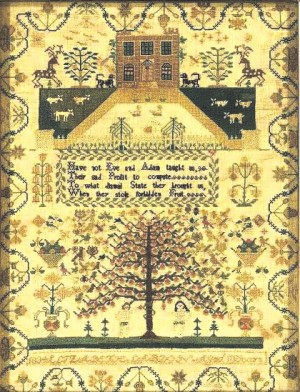Our forefathers have left us many incredible examples of their talent and craftsmanship over the past centuries. But just as significant, although sometimes overlooked, are the contributions of the housewives of yesteryear. From folk art and hand-painted china to needlework and quilts, the beautiful pieces created by the talented women of past generations have survived and found their way into today’s collectible market. Among them are the intricate hand-work pieces known as samplers.
The samplers collected by today’s enthusiasts come mainly from the works of the young women of the 18th and 19th centuries. “Sampler,” taken from the Latin word Exeuplum, meaning “an example to be followed,” is true to it’s definition. With no printed examples available to follow, those who crafted samplers were dependent upon the works of those who preceded them. When a woman found a stitch that appealed to her she would add a small example of the stitch to a piece of fabric that she kept as her “sample.” These collections of random stitches were cherished and added to by future generations and a cherished find to the serious collector.
In the late 1700s map samplers came into vogue. While they are highly inaccurate geographically (due to the nature of the medium), they are some of the most intricate pieces ever made. From this time period of “educational samplers” you will also find almanac samplers, alphabet samplers and those with mathematical times tables. Unlike the elaborate samplers that would become popular as we crossed into the 1800s, these earlier works were very crude in appearance and void of any decoration. They are most difficult to find and demand high dollar at specialty auctions.
The double benefit to the young girls who made “educational samplers” was the mastering of their sewing techniques while learning to count, acquire a knowledge of geography and say their ABC’s. These samplers will be signed and dated by the girls who made them and in some cases will have the name of their school. Borders became much more elaborate by the early 1800s, a factor that will help you in determining the age of undated pieces. Watch for examples that incorporate elements of nature such as birds, small animals, flowers and trees. The presence of these will indicate a high level of skill in the seamstress and are among some of the more valuable from this time period.
Religious samplers became popular during the American Victorian period of the late 1800s. They will often feature the Virgin Mary or a cluster of angels and will have been made with heavy velvet thread. Bible verses or tributes to the Lord (often in German) are often present on these samplers. More rare, but worth the search, are samplers made as a memorial to a loved one. These incorporated the use of dried flower (often from a funeral), ferns, and in some cases actual human hair.
As we entered the 20th century the interest in sampler stitching sharply declined. The view of a woman’s role in society had changed, educational opportunities were on the increase, as was technology, and the traditional role of the woman as a wife and homemaker was drastically altered. The stitching of samplers, which had once been viewed as a sign of virtue and achievement for young women, waned by the late teens and all but vanished from American culture by the 1920s.
Today we are seeing a renewed interest in samplers with a number of nice examples currently available on both Etsy and eBay. Until next time . . . Linda
Linda Kennett is a professional liquidation consultant specializing in down-sizing for seniors and may be reached at 317-258-7835 or lkennett@indy.rr.com



